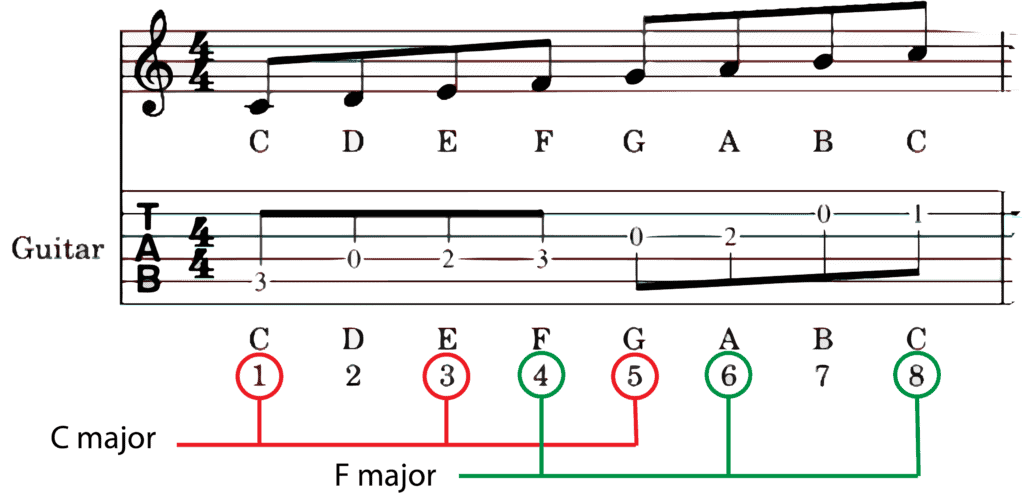Finding the chords in a key is a lot easier than you might think, especially in most modern-day music.
Leaving out Jazz music and classical or advanced music theory, playing most songs is pretty straightforward.
There are generally only seven chords in any key and of those chords, we mainly use four. The major root, the major fourth and fifth, and the minor sixth.
But this doesn’t make too much sense if you don’t really know the notes and the chord qualities of all these intervals in the scale.
In this article, you will learn about some useful hacks to make this process way less overwhelming.
Here are 5 easy tricks to find the chords in a key:
- Stacking thirds
- Knowing the notes on the scale
- Using the first fourth fifth pattern
- Using the L7 pattern
- Counting on your fingers
Let’s take a look at some of these tricks you can use to find the chords in any key.
1. Stacking thirds
So if you’re new to music theory, thirds refer to the third note up from the note you’re on. For example, if you were to play the third up from C it would be E.
If C is 1 and D is 2, then E would be 3.
Most chords are made up of a triad, which is three notes together, and they’re often stacked in intervals of three from each other.
The third up from E would also be the 5th up from C, it sounds weird but you’re counting E as a 1.
So it would be E, F G, G is the third of E and the 5th of C.
When you put those notes together, you CEG, which are the notes for the C major chord.
You also have the interval of 1,3,5.
You could say that all of the chords on any diatonic scale are built out of this 135-interval pattern:

I’d say when it comes to learning to discern chords, start in the key of C and G because they have the most natural notes.
2. The scale and the chord progression matches
If you know the major of any key, you will be able to build the chords off of that too. Let’s stick with C for this example.
The C major scale has the notes CDEFGAB. These are also the C major scale chords.
The part that requires memorization is knowing which notes are minor and which are major.
This is a bit of music theory, but you can simply remember by saying: Major, minor, minor, Major, Major, Minor.
The seventh chord is a diminished chord, but it’s rarely used.
Another way to remember this pattern is the way that it’s notated in chord diagrams or scales and interval patterns.
They’ll usually represent the intervals with roman numerals, the major will be capitalized and the minor chords will be lowercase.
3. An unusual pattern
So this is related to the linked youtube video, but if you don’t feel like watching it, here’s the gist of the pattern:
You place your fingers as if you were to play a power chord for the first note of the scale you are interested in getting the chords to.
Then, only focus on the first, fourth, and fifth intervals you can reach from there.
Remember the fourth would be in the same fret number but a string below, and the fifth is 2 frets upwards in that same string.
These 3 notes you get are the major chords of the major scale.
Now move this pattern 3 frets downwards, if you were in C you will land in A.
Same thing here, but this time the 3 notes represent the minor chords in the key.
The one note missing is 2 frets upwards, or just 1 before your starting point, and that note is for the diminished chord of the scale.
4. Guitar Sage’s L7 pattern
Another youtube channel: your guitar sage, has this pattern, originally named the major minor sixty-niner, because of how the pattern shape resembles a 6 and a 9.
He changed it to L 7 to be more PG.
Anyway, this is how the pattern looks and you’ll notice it’s very similar to the previous pattern, but with a slight difference.
The first three notes are all major chords and the next three are minors.
The main thing to keep in mind with both of these patterns is that you still need to know the chords.
If you aren’t sure what a G major looks like, you can at least google the chord shape now.
5. Counting on your fingers
This is a trick I came up with, I haven’t seen other people doing it, but I’ve always found it very useful, especially in conjunction with the other methods.
You use your fingers to note the intervals and the tones and semitones, and then you can simply insert the root note and count it out.
How many chords are there in a certain key?
It kind of depends on the key and the whether it’s a simple key or a more complex key.
For example, the major and minor keys only have 7 notes in them, but the major harmonic and major melodic scales are both a little different.
For simplicity’s sake, we’ll stick to the major and minor scales for the scope of this article.
In this case, there are only 7 chords to learn.
You also get borrowed chords, which can add an interesting tone to the chord progression.
In the key of C, the 3rd chord, E minor, can be changed into an E major for a very interesting and tense sound.
You can hear it in Skinny by Kaleo.
The fun part is that this is just scratching the surface, if we take modes into account, chords become a lot more unusual and interesting.
But we’re sticking to the Ionian for today.
Regardless of the extras, it’s important to note that in most modern, western music, you’ll only have 7 chords to work with.
How to memorize the chords in a key?
Using those previous tricks we learned, it becomes quite easy to memorize the chords in any key.
Let’s use that L7 pattern again. If you pick any note on the E string and play it, let’s say… the 5th fret, which is an A note.
We can implement this pattern to find the major chords in A, which are A, D, and E, and the minor chords, Bm, Cm, and F#m. G# is the diminished.
But what if you don’t know the notes in the chords? We can just stack the thirds.
So you can take A and count on your hand to get C# and E.
Continuing on with the other chords, you’ll be able to find their shapes too.
Chord functions in a key
Chords are used to make up the rhythmic segment of most songs.
Especially in music with a guitar, you won’t generally strum just one note. But we can say a lot more about chords than that.
What you’re doing when you play two notes simultaneously is called harmony and harmony accounts for feeling in songs.
I like to think of riffs and hooks like the line that makes the song recognizable, but the chords create the feeling of the song.
They may not be the memorable part, but they’re what gives color to the song and give structure during changes from verse to chorus
Most progressions consist of three or four chords, the same way you count in fours and sometimes threes.
This tends to give a measure of movement while maintaining stability.
Five or six chords start to sound weird and playing a progression over six measures can start to sound stretched out, but it’s not to say that hasn’t been done to good effect in modern music.
David Bowie actually did this quite well in some of his music, the same can be said for Queen.
They would mix classical music harmony and theory into their rock and it was awesome.
For a beginner though, stick to the 7 main chords in the major key and you’ll do just fine.

Hello there, my name is Ramiro and I’ve been playing guitar for almost 20 years. I’m obsessed with everything gear-related and I thought it might be worth sharing it. From guitars, pedals, amps, and synths to studio gear and production tips, I hope you find what I post here useful, and I’ll try my best to keep it entertaining also.





